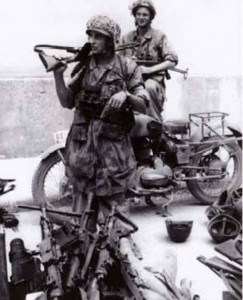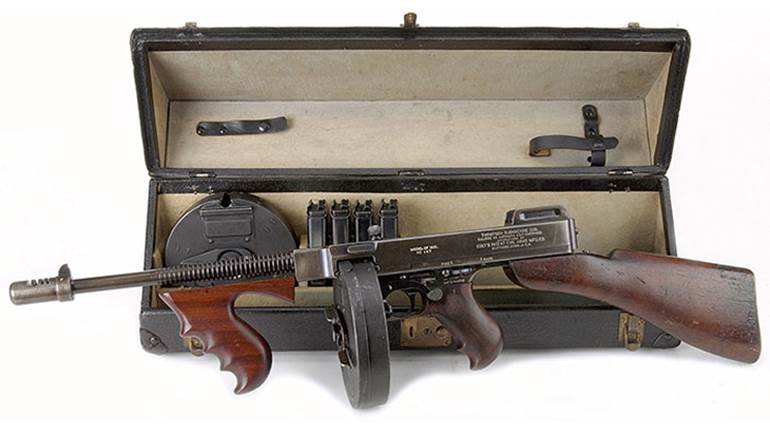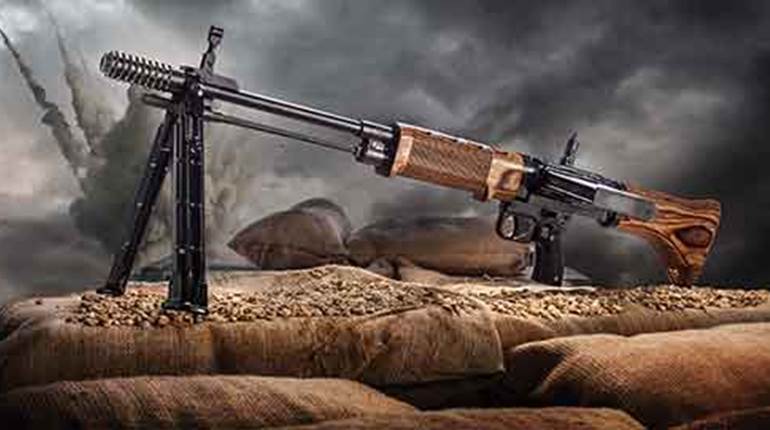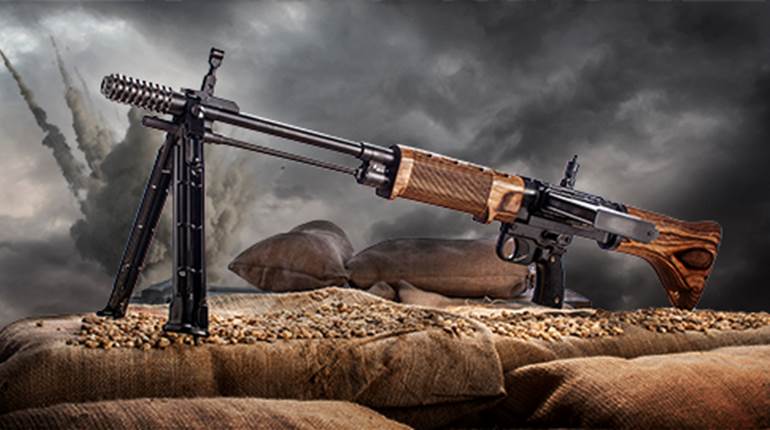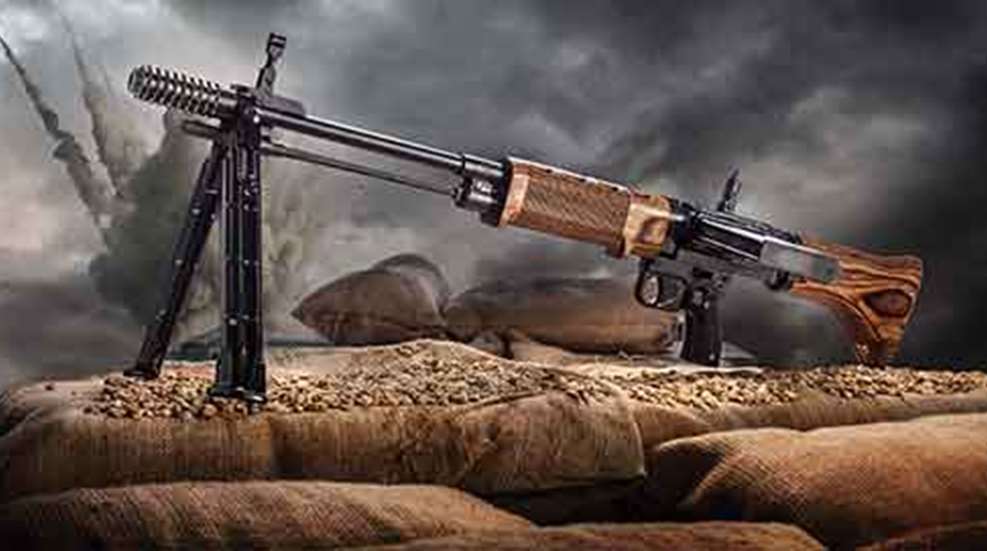
It’s all about the rush you get when you confront a firearm with a unique orchestration of design and engineering that transcends design and engineering and becomes compelling purely on esthetic grounds-somehow a part of the inner landscape of your imagination. The Peacemaker, the Thompson, the Colt .45, the Luger, the MP-40, the Russian PPSh and the AK series, maybe a few others share this characteristic.
But for me, none more so than the German FG-42, the German paratroop rifle-“FG” decodes to Fallschirmjägergewehr, in English “Parachute Infantry Weapon”-perhaps the strongest cult gun to emerge from World War II.
See it once, remember it forever. I’m thinking my first glimpse had to be in the ’50s, in a mail-order DEWAT (Deactivated War Trophy) catalogue, a bible of misspent youth. The de-functionalized gun probably went for less than $20 in the day when a full-auto could be retailed through the U.S. Mail for the cost of the lead to fill the barrel and the services of somebody to remove the firing pin. The process was entirely unremarkable for years. But don’t get caught with an unregistered one now.
There it lay in that volume’s bluish ink-or so memory insists-on a 45-degree angle across the page, a firearm that seemed to have a past and future but no present. From yesterday it took the swooping streamlines of art moderne as seen in the graceful, violin-esque abstract of its stock, that little prong of a handguard to anchor the shooter’s hand to the fore-end and its oh-so-1928-Thompson compensator at the muzzle’s end. From tomorrow it took a rakishly angled grip, pugnacious trigger guard, straight-line design, folding bipod, bayonet and sights and its general air of raffishness.
It was jet-propelled and old-fashioned at once, and it had the further fascinating enigma of a horizontal magazine system, like a Sten on steroids, requiring a box of 20 full-bore Mauser cartridges locked into the left of the receiver, invisible in many right-side photographs. But it seemingly had nothing to do with the earnest, blocky, defiantly utilitarian guns that fought World War II. By contrast, the FG-42 had panache.
See it twice, and yearn to hold it. Yet I’m not sure where I could have seen it that second time. It was so rare that it never appeared in movies, a constant source of gun display in those days, or in the D.C. line of war comics, another gun showplace so all-consuming that it explains to this day why I never learned my multiplication tables. Maybe now and then it could have shown up in LIFE magazine photo essays of peasant guerillas in some jungle somewhere, Africa, South America, Indo-China. I see it gripped by a serious bare-chested guy barefoot and wearing ragged shorts, crossed bandoliers of ammo-maybe machine gun belts. How he got an FG would make quite a tale, an odyssey beginning in a moldering East German warehouse and tracking its way through shadowy ports out of Conrad with NKVD sponsorship to the ambush zone, but its 8x57 mm Mauser chambering would make it a player in the game of world revolution, with such plentitude of surplus ammo available.
See it three times, and write a book about it. That’s what happened to me-I saw it the third time in my mind’s eye as I contemplated a book with German paratroopers as good guys (like Jack Higgins' usage of them in The Eagle Has Landed, later a movie with Michael Caine as a heroic ‘jaeger colonel), and I knew they had to carry what Michael Bane said was “only the coolest gun in World War II.”
As a novelist I get to care about cool. If you’re a collector, you do, too. If you’re an investor you really care about cool because cool equals value. If you’re designing the thing, cool probably isn’t on the agenda; it’s not an end product, but a byproduct. If you’re facing an advancing wall of infantry called the 1st Ukrainian Front, cool again probably doesn’t matter much. Still, for most of us: Cool is as cool does. And that’s what explained my presence in a gun vault where Dan Shea, the CEO of Long Mountain Outfitters in Henderson, Nev., and owner of one of the largest private collections of Class III arms in America, had laid out three of the very rare German rifles for me to admire and play army with. I don’t think I could have written Sniper’s Honor without that experience.
Better, of course, to have fired it, but the few remaining FG-42s in the world (only about 7,000 were built, and many were lost in combat) are worth more than your last two houses. You do not want to run a round through them. Ka-boom, and you owe somebody two houses. So the shooting was out. (See Stephen Hunter fire an SMG Guns FG 42 Fallschirmjägergewehr at the end of this article.)
But handling was not.
The first thing, of course, is its lightness of being. Firearms are always a surprise in how heavy they are in proportion to their size-all that steel-but with the FG, it’s the opposite. Mostly stamping with either plastic or wood laminate furniture, it’s quick to the shoulder, and with sights popped, quick to the eye. It feels a bit like a Kreighoff shotgun, which is no surprise as it was actually built by Kreighoff between 1942 and 1944. Everything about it suggests high-speed operations, though at the same time, it reflects the ergonomic philosophy of the ’40s: “You know that pain from all the sharp corners banging into you? Get over it!” The handiness reveals its origins as a German sky soldier’s dedicated piece, meant not to be lugged across a continent for years and used to hammer tent pegs as well as take hills, but to ’chute in, take the objective in a quick, violent strike, then go back to schnapps and sausage while the plowboys of the infantry mop up and secure the perimeter.
Like all plans, this one fell apart in actual usage. Initial lightning-strike deployments in the Low Countries turned paratroopers into Reich superstars, but along came Crete in 1941, a bruising, bloody battle in the Aegean that taught the paratroopers a harsh lesson. They took heavy casualties in their jump onto the island when cool-headed British Tommies with .303 Lee-Enfields picked them off in the dozens as they raced about to find their weapons canisters. The doctrine at that time was to jump with handguns as primary weapons, while canisters carrying heavier weapons went out the door with them, and had to be found, opened, and distributed before action.
After that, Hitler soured on the big drop theory. The 10,000-man Fallschirmjäger divisions ended up in pitched battles, fighting essentially as specialized defensive infantrymen. Never again were they to jump on a large scale; they were sent where the fighting was heaviest-Monte Cassino, the Neva River in Russia, Normandy-where their reputation for courage, resilience, gallantry and creativity was well earned. The new gun they demanded was already in the pipeline, at least for a little while. (By late war, it had been de-prioritized, which is why so few were built.)
The gun may also have represented a bit of elite-unit vanity. After all, commandos pretend to top-secrecy but at the same time, they like the world to know they are the chosen few. The Fallschirmjäger were already singular: their helmets had been conspicuously trimmed of that ear-and-nape-of-neck flange so Teutonic in profile that marked the stahlhelm; instead, to prevent the rim of the pot from cutting the ripcords as they descended, their helmets fit like mushroom caps. They wore bloused lace-up boots (you need laces if you’re going to hang beneath a parachute), a camouflage tunic they called a “bone bag” and carried a stainless steel gravity knife for cutting cords, shrouds and throats.
After Crete, Hermann Goering, who was head of the Luftwaffe to which they belonged-as opposed to the more hide-bound, conservative army-okayed the radical nature of the FG-42. (He also owned Rheinmetall, the company that initially contracted to produce it, so he was selling it to himself at a significant profit, being as corrupt as he was corpulent). As they put together the specs for the new arm, the paratroopers managed to create a tactical niche that it has taken the rest of the world 70 years to appreciate. Yes, the gun had to be light, but at the same time, contra expectations and consensus, they wanted it to retain full rifle power. In short, they did not want a carbine, a submachine gun or even an assault rifle, all of which fire light caliber rounds. They wanted what physics said could not exist: a little big rifle capable of providing full-automatic suppressive fire.
Ingeniously, the German engineers on the project came up with a twist by which the rifle fired from a closed bolt when in semi-automatic mode, which gave the piece great single-shot accuracy; and, for cooling purposes, from an open bolt at full-automatic, definitely necessary for a ripper with a 900 round-per-minute cyclical rate, as fired through a thin, unchangeable barrel.
The gun they got, after the usual plots, counterplots, backstabbings and stupidities of the Reich’s arms-production protocols, exacerbated by declining access to raw materials and relentless factory bombing, was light, sleek, had extraordinary pointability and accuracy and, because physics, in the end, can’t be defied, kicked like the mother of all mules. Someone has called it “a ten-pound MG-42.”
Which of course brings up the issue, to what degree was it fired on full automatic and was it designed to fulfill squad automatic weapon requirements? My answers, strictly an amateur’s, would be seldom and no.
As a “light machine gun” its utility is greatly proscribed by the 20-round magazine limit and that thin barrel. It had no provision for belt feed and the constant magazine changes would have prevented building a solid base of fire under which attackers could maneuver. Then, the heavy-weight 8 mm Mauser cartridges would have precluded carrying large amounts of ammo. Paras carried 20 magazines in a special harness-like strip over their bonebags, meaning each guy had 400 rounds which would last a light machine gun in fire suppression mode about three minutes. As well, all examiners agree that the bipod system is the gun’s poorest design feature and presume that soldiers must have improvised ways to brace, or strengthen the torque of the legs against the gun in full-automatic fire. Finally, sustained full-automatic recoil would have been brutal, given the gun’s weight against the full rifle kick. Clearly, the Germans realized this and made attempts to ameliorate the recoil issue in subsequent iterations. Later variants encase the light stock in a buffer system, so that the recoil is driving against a powerful spring mounted internally. The muzzle brake probably does a little but less than hoped in this regard.
It was primarily a raid arm, and my guess is the Green Devils used it mostly in the semi-automatic mode. Its pop-up sights, which would not be seen again for 60 years until they became de rigueur for well-dressed American ARs, were calibrated for longer-range shooting, so the shooters could return fire-always fighting the last battle!-on the Tommies picking them off from the olive trees. At the same time its shortness (original specs called for one meter) and light weight made it ideal for entry work, urban scenarios and instinct firing. It was ideally suited for stairways and alleys in a ruined Italian town, as too many G.I.s found out on the slopes of Monte Cassino or if they chose concealment over cover. The Mauser 8 mm would not be stopped by doors or brick.
But then there’s the grip. Help or hindrance? Practical or affectation? These are fascinating, in the end, unanswerable questions though the German designers thought they had an answer. The grip is the first thing they fixed on a second run of guns, the last 6,000, designated officially FG-42/II. But it was a strange decision, almost, in a novelist’s humble opinion, a kind of desecration. The new grip-far from taking inspiration from the esthetically distinguished sweep of the Luger or even the at-least-20th century P.38-for some reason approximates the shape and angle of a Webley revolver or a Colt New Service. It is joined to receiver at a close-to-90 degree angle and looks totally out of place, like some welder’s midnight inspiration best disassembled in the morning. How could they do this to such a beautiful piece?
I can’t help feeling melancholy at the “improvement,” since the severe rake of the first grip is the gun’s signature trope. It was, or so the story goes, officially designed to facilitate firing while descending, even if that makes little sense upon reflection. German paratroop doctrine got the boys out of the Junkers 52 tri-motors at very low altitudes, so there would not have been much time in descent. I think some lowly apprentice draftsman penciled it into the design late one night because he knew how cool it was!
A great design doesn’t fade, it mutates. You see FG influences everywhere, even today, both mechanically and stylistically. In fact, that icon of the Vietnam War, the M60, is its direct descendant, incorporating many of the same stylistics and improved by adding weight and a belt-fed mechanism. The stocks are about identical, proving that someone at Aberdeen in the ’50s did a lot of playing with the FG-42. I have to note that whoever did so “unfixed” the grip. He did away with that revolver-like anomaly and restored the streamline, making it whole and coherent once again. I’m sure there was a sound practical justification, but I also know the guy secretly felt he’d righted a big wrong.
You can also make the case that the FG was a necessary evolutionary step on the way to the bullpup configuration, which by now seems like the future of assault rifle design. The Germans had the imagination to work outside of the box and, in fact, they broke the box. They just didn’t know quite what to do with the parts. They realized they didn’t have to cling to the linear barrel/magazine/trigger/grip/stock model but as long as they had a barrel, a magazine, a trigger, a grip and a stock, they could put them together any way they wanted. In moving the magazine to the left side of the receiver, they saved inches off the long end and cleared the internals for more efficient mechanics.
But they just were conceptually unable to make the next step, which was to move the magazine behind the grip and the trigger. That bold move was left to the British with their radical EM-2 of 1948-who then forgot it for another 50 years. But now we seem to be on the cusp of a golden age for bullpups, with the British SA-80, the French FAMAS and, most successfully, the Israeli Tavor. And who knows what’s on drawing boards now?
It is often alleged of the FG-42’s sibling, the StG-44, that had German industry gotten enough of them to the troops, it might have changed the course of the war. That can’t be said of the FG, for many reasons, but chiefly for the violence of its recoil which would make any soldat dump it the first chance he got. In the end, it is probably greater for what it became than for what it was. But that will never change the fact that in the imaginative sense, it is one of those rare guns that you never own; it owns you.
